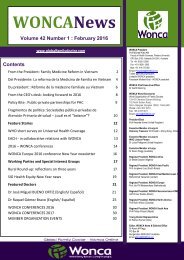You also want an ePaper? Increase the reach of your titles
YUMPU automatically turns print PDFs into web optimized ePapers that Google loves.
CARDIOVASCULAR DISEASE (CVD) RISK: ROUTINE CAREAssess the patient with CVD riskAssess When to assess NoteSymptoms Every visit Manage symptoms on symptom page. Ask about chest pain 15, difficulty breathing 16, leg pain 36 and symptoms of stroke/TIA 76.Risk factors Every visit Ask about smoking, diet, exercise and activities of daily living.BMI Every visit BMI is weight (kg)/[height (m) x height (m)]. Aim for < 25.Waist circumference At diagnosis, yearly or 3 monthly if trying to lose weight Measure waist circumference on breathing out midway between lowest rib and top of iliac crest. Aim for < 80cm (woman), 94cm (men).BP Every visit Diagnose and treat hypertension depending on CVD risk 73. If known hypertension give routine hypertension care 74.CVD risk At diagnosis, then 5 yearly If CVD risk ≤ 20%, show the patient what his/her risk might be in 10 years using current BP, BMI and smoking status.Glucose At diagnosis, then depending on risk 70 Timing of repeat diabetes screen depends on risk factors 70. If known diabetes give routine diabetes care 71.Total cholesterol At diagnosis if CVD risk > 20% Check random total cholesterol. If ≥ 7.5, refer to specialist. No need to repeat.Advise the patient with CVD risk• Discuss CVD risk: explore the patient’s understanding of CVD risk and the need for a change in lifestyle.• Invite patient to address 1 lifestyle CVD risk factor at a time: help plan how to fit the lifestyle change into his/her day. Explore what might hinder or support this. Together set reasonable target/s for next visit.Physical activity• Aim for at least 30 minutes briskexercise at least 5 days/week.• Increase activities of daily living likegardening, housework, walkinginstead of taking transport, usingstairs instead of lifts.• Exercise with arms if unable to uselegs.Smoking• Urge patientwho smokesto stop.Diet• Eat a variety of foods in moderation.Reduce portion sizes.• Increase fruit, vegetables and low fat dairy.• Reduce fatty foods: eat low fat food, cutoff animal fat, replace brick margarine/butter with soft tub margarine.• Reduce salty processed foods like gravies,stock cubes, packet soup. Avoid addingsalt to food.Weight• Use less sugar.• Aim for BMI < 25, andwaist circumference< 80cm (woman) and< 94cm (man). Any weightreduction is beneficial,even if targets not met.Manage stress• Perform a relaxing breathingexercise each day.• Find a creative or funactivity to do.• Spend time with supportivefriends or family.• If patient is stressed 52.Screen for alcohol/substance misuse• Limit alcohol intake to 2 drinks/day (man) and1 drink/day (woman). 1 drink is 1 tot of spirits,a small glass of wine or 1 can of beer.• If patient exceeds these limits or abuses illicitor prescription drugs 83.• Identify support to maintain lifestyle change: health education officer or dietician/nutritionist, friend, partner or relative to attend clinic visits, a healthy lifestyle group, helpline back page.• Be encouraging and congratulate any achievement. Avoid judging, criticising or blaming. It is the patient’s right to make decisions about his/her own health. For tips on communicating effectivelypreface.Treat the patient with CVD riskGive the patient with CVD risk > 20% simvastatin 10mg for life.69



